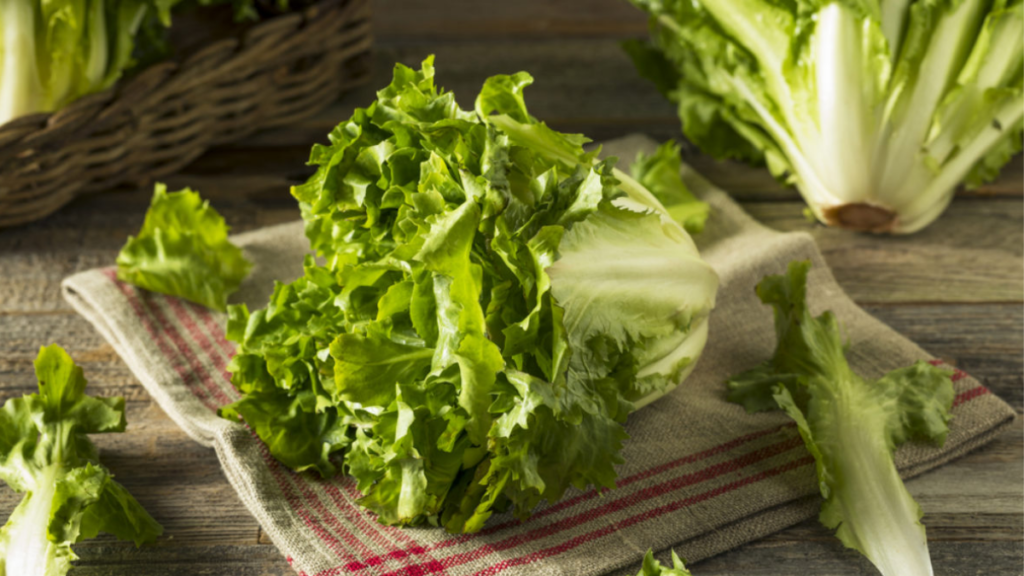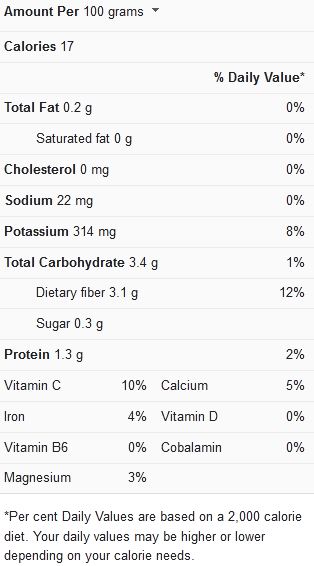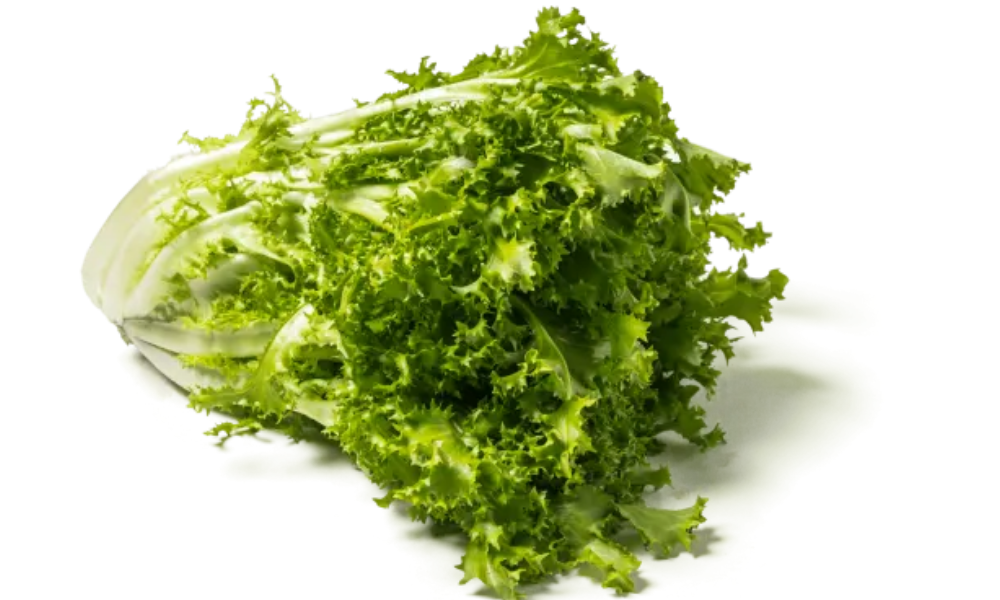Escarole is a fantastic choice to add to your diet when trying to lose weight, whether you use it as a salad green or a savory side dish. To eat a balanced meal, mix escarole with a nutritious grain or starchy vegetable, such as potatoes, and a low-fat protein, such as turkey or fish. Escarole has 0.2g of fat and only 1.3 grams of protein per 100g. It does, however, contain 3.4 grams of carbs. Because carbohydrates are your body’s primary fuel source, this quantity will not cover your energy demands for the day, so be sure to complement your diet with carbohydrates-rich meals.
Escarole is a good source of dietary fiber. Fiber is essential for the health of your bowels since it lowers your risk of constipation, diarrhea, and diverticulitis. Escarole provides 30 percent of the daily required vitamin C consumption in one serving. This antioxidant vitamin protects your cells and tissues from free radical damage and aids in their repair. It also aids in the production of collagen, a protein found in ligaments, tendons, cartilage, skin, and blood vessels.
Escarole Nutrition Facts
What is Escarole?
Escarole (Cichorium endivia) is a chicory family member. Curly endive, radicchio, frisée, and other bitter green vegetables are among its botanical relatives, including curly endive, radicchio, frisée, and other bitter green vegetables. Escarole is a type of endive that has flat leaves.
Belgian endive is a yellow-green plant thickly layered, and cylindrical leaves are frequently referred to as “endive.” Regardless, you’ll typically find this hardy plant with the kale and lettuces in the grocery. While escarole and butterhead lettuce have similar appearances, the difference is that escarole has wide, green leaves with somewhat jagged, crumpled edges that cluster into a rosette, whereas lettuce leaves are wavy and smooth.
Escarole, unlike lettuce, has excellent sharpness and is versatile, and curly endive is gentler and more delicate. While escarole is native to the East Indies, it grows in various climes and may be found worldwide, and it’s particularly well-liked in Italian cuisine.
What Are the Health Benefits of Escarole?
Escarole is nutrient-dense and boasts many potential health benefits.
May Promote Gut Health
Soluble and insoluble fibers have various effects on the human body. While soluble fiber bulks up your stool and feeds your gut flora, the insoluble fiber goes through your digestive system undamaged, improving gut health by pushing food through and encouraging bowel movements.
Escarole, in particular, is high in insoluble fiber. It can help keep your bowels regular and minimize the discomfort of constipation and piles by providing 12 percent of your daily fiber needs per 2 cups (85 grams). Eating escarole frequently can aggravate kidney stones in persons who already have them. Its high oxalate content – a plant chemical that aids in removing excess calcium — could be to blame as your kidneys filter oxalate.
May Support Eye Health
Escarole is high in provitamin A, with only 2 cups giving 54 percent of the daily value (85 grams). This vitamin is vital for eye health since it’s a component of rhodopsin, a pigment in your retina that lets you distinguish between light and dark.
Chronic vitamin A deficiency has been related to vision problems such as night blindness, in which patients have trouble seeing at night but not during the day. Vitamin A deficiency has also been linked to macular degeneration, an age-related loss of vision that can lead to blindness.
May Reduce Inflammation
Escarole is high in antioxidants, which are substances that protect your body from oxidative stress and unstable molecules known as free radicals, in addition to its impressive nutrient profile. Inflammation may be triggered by long-term oxidative damage.
According to research, kaempferol, an antioxidant found in escarole, may protect your cells against chronic inflammation. However, these experiments are limited to rats and test tubes, and more human study is required to comprehend kaempferol’s impact on inflammation completely.
Bone and Heart Health
Vitamin K is necessary for appropriate blood clotting and calcium regulation in the heart and bones. Vitamin K1 is a kind of vitamin found in leafy greens like escarole. Per 2-cup (85-gram) raw serving, this vegetable provides 164 percent of your daily needs for this vitamin.
A two-year trial of 440 postmenopausal women demonstrated that supplementing with 5 mg of vitamin K1 daily reduced bone fractures by 50% compared to a placebo group. In addition, a three-year study of 181 postmenopausal women found that combining vitamin K1 and vitamin D dramatically reduced artery hardening linked to heart disease. Vitamin K deficiency has been linked to a lower risk of heart disease and dying from it earlier in life.
How to Prepare and Eat Escarole?
Escarole is a versatile vegetable that works well in raw salads and heartier meals. The bitter, chewy outer leaves are replaced with sweeter, tenderer yellow inner leaves. The bitterness of raw escarole is balanced by an acid such as lemon juice or vinegar. Cooking it will also assist in smoothing out harsh flavors if you’re sensitive to them. You can sauté it or add it to a soup in this way.
Escarole can also be used on the barbecue. Cut the vegetable lengthwise into fourths to grill it. Then use canola oil, which has a higher smoke point than most other oils and is less prone to produce hazardous chemicals when heated to high temperatures. Then season with salt and pepper and cook for 3 minutes on each side. Serve with your favorite sauces or dips, like a lemony Greek yogurt dip or a white bean dip.
How to Use Escarole?
Most grocery stores, farmer’s markets, and health food stores carry this wonderfully versatile ingredient. It’s commonly available in the vegetable department with greens like kale, lettuce, and romaine. Thanks to its bright color and distinct flavor, there are various ways to enjoy this brilliant veggie.
It’s delicious served raw in an escarole salad or fruits like apples and pears. Escarole lettuce can also be cooked and utilized in meals such as pasta, stews, and side dishes. Escarole soup, often known as Italian wedding soup, also contains it.
What Are the Side Effects of Escarole?
Although allergic responses to escarole lettuce are rare, they have been documented. If you get any symptoms like hives, rash, itching, or swelling, stop using it immediately and consult your doctor.
If you’re on Warfarin or another blood thinner, you should limit your intake of leafy greens like escarole lettuce. This is because abrupt changes in vitamin K intake might reduce the efficacy of these medications, which can have negative health consequences.
Conclusion
Escarole lettuce belongs to the chicory family of plants and is a sort of leafy green vegetable. It’s linked to endive, Belgian endive, and frisée, among other greens. Escarole has a low-calorie count but is abundant in fiber, vitamin C, and vitamin A. A minor quantity of calcium, vitamin K, and iron are also present in each serving. It has a slightly bitter and robust flavor and broad green leaves that are adaptable and easy to include in cuisines. Escarole has long been a popular component in other parts, including ancient Greece and Egypt, despite its origins in the East Indies. This tasty leafy green has been produced in England since the 1500s, according to historical documents, and was later introduced to the United States by early colonists.
Escarole is broad-leafed endive with somewhat crumpled, jagged leaves that resemble butterhead lettuce. You can sauté it or add lemon juice or vinegar to balance the bitter taste. This veggie is suitable for your eyes, intestines, bones, and heart, among other things. It’s delicious in salads and soups, and it can even be grilled. Give this distinctive leafy green a try if you want to change your veggie regimen. Before consuming your escarole, make sure to wash it thoroughly. People on blood thinners or who have kidney difficulties should watch their consumption. Escarole can be eaten raw in salads or cooked in various ways, such as sautéing and grilling. Its bitterness can be reduced by adding acids or boiling it.



